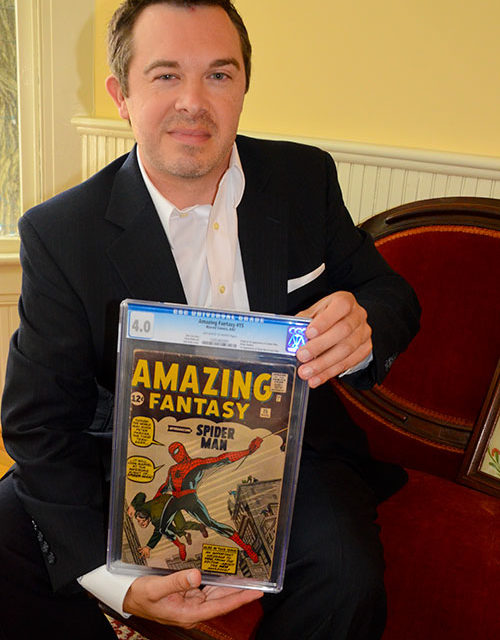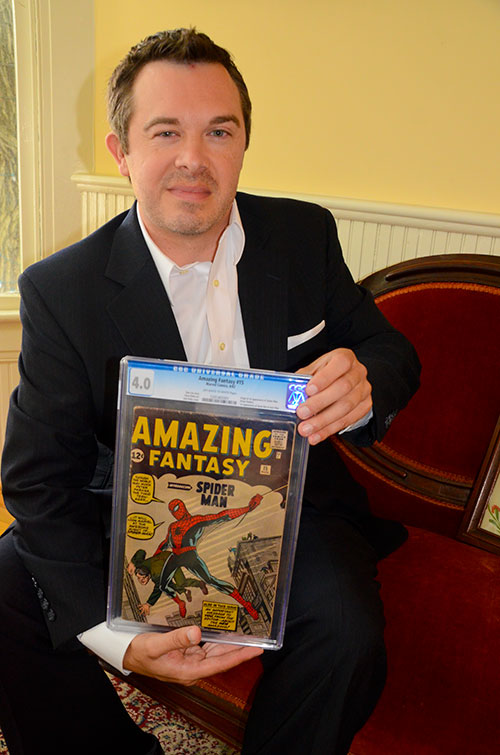by Lisa Moody Breslin photography by Phil Grout
Tom Gordon III can hold history that reaches as far back as Dutch artist Rembrandt van Rijn in his hands.
While others turn pages in books or read internet accounts about John Surratt, John Singleton Mosby, Betsy Patterson Bonaparte, Theodore Roosevelt and John Wilkes Booth, Gordon and four generations of his family members have a link to their histories that is more direct.
Actor and assassin John Wilkes Booth’s ring; an admission ticket to the trial of conspirator John H. Surratt; Betsy Patterson Bonaparte’s silver engraved personal card case; letters and autographed photos from Theodore Roosevelt to his great great Uncle Philip G. Straus.
Each item is a piece of history the Gordon’s have collected.
Since his great, great, great uncle, Philip L. Straus, traded with the Crow Indians, Gordon’s life as a fifth generation collector can’t be teased out of what he does each day. Whether he scans the salt and pepper shaker during a breakfast interview or takes a call from someone who has a tip about an estate sale, Gordon experiences the immediate, the past and the future as a collector.
“I started collecting when I was five years old,” Gordon said. “Rocks, fossils, objects like that. For my family, collecting must be genetic.”
“It is not about the money,” he added. “We love the social aspect. Imagine generations of family members who love to run for the thrill of the hunt. It has always been about the time together and time with other people who share the stories about things we collect. I was blessed to share this passion with my Grandfather and father on a regular basis”
Comic books, coins, autographs, art, photographs – the Gordon collection is vast and broad.
For a quick inventory, Tom Gordon offers responses to the following prompts about the collections:
Oldest: A Rembrandt etching.
Wow Factor: A replica copy of the Dunlap broadside version of the Declaration of Independence (created R. R. Donnelley & Sons Company).
Most Heart-Touching: Early family photos, letterhead stationery, glass bottles – from Monumental Brewing Company, which was a family owned brewery in Baltimore pre-Prohibition.
Most Whimsical: A damaged 1956 Witch Regular Pez dispenser found in a sandbox and then taken to the Westminster Antique Mall. Worth: $800.
In Best Condition: A promotional dental comic book from 1949 titled Kolynos Presents The White Guard which was CGC certified a 10.0.
Worst Condition: Superhero Comics from 1940s – filled with insect chews and musty.
Fast fact about those comics: Fawcett Publications created trading cards on several 1940s Superhero covers. Gordon found out that actor Walter Koenig, who rose to fame in the 1960s as Mr. Chekov on the television series Star Trek, collected the cards and was missing several. Gordon met Koenig in San Diego and sold him the cards. Amount: Undisclosed.
Biggest Deal: Over 350,00 books from a house in Tampa, Florida.
“It has been a surreal experience,” Gordon said. “Tucked in an unassuming house, all neatly organized in tomato boxes, were these comics. There were 500 in the kitchen alone. And the garage, from floor to ceiling – stacked tomato boxes filled with comics.”
Collecting is “like panning for gold,” Gordon explained. “Collectors have that prospector mentality. Some are motivated by money. But for my family and to me, items are a connection to history. The best thing about collecting is the people we meet and their stories.”
People keep things for their connection to someone else or an experience. Gordon added. “They save because they care, especially older generations. I lost four grandparents within a year and I’m thankful to have the Navy sweetheart pin that my grandfather gave to my grandmother. It was the first thing he ever gave her and it still has the handwritten note she kept with it.”
Gordon also embraces a sense of responsibility that accompanies collecting. Many of the items he collects should be saved and, sometimes, should (and do) go back to museums.
“Very often, collectors become the stop gap, a way station, for important items until they make it to a museum or back where they belong,” Gordon said.
Where they belong?
Gordon’s great, great uncle, Philip G. Straus, acquired pieces that were broken off of Declaration of Independence signer John Hancock’s chair at the Graff House in Philadelphia – the very chair that Hancock sat in when he signed the Declaration of Independence..
“Evidently the piece of Hancock’s had been broken off by someone who had a penchant for taking piece from historic sites in the 1840s,” Gordon explained. “My great Aunt, Grandfather, and father returned the piece of Hancock’s chair in the late 1950s after my great great uncle passed away…At first the curator was adamant that the relic couldn’t be the piece missing from Hancock’s chair. Once he placed it on the chair, it perfectly and the rest is history.”
Another family find – Lincoln’s first appointment book from when he was in office as President – comes to mind when Gordon recalls items that journeyed back to where they belonged.
Gordon’s father, Tom Gordon Jr., remembers sitting on his Uncle’s lap as a small boy and looking at Lincoln’s day book before it was sold by Parke-Bernet Galleries and then later returned to The White House.
Eager to see Lincoln’s day book, Tom Gordon III contacted the White House and garnered an invitation.
“There is no way to describe the feeling of experiencing current history – the White House, the china room – and the past – President Abraham Lincoln’s day book, “ Gordon said. “Collecting opens so many doors.”
Collectors get tips about antiques and collectibles by word of mouth. At the local post office, barbershop, or possibly the coffee shop, there are many places to acquire tips from people.
Estate sales run by a reputable auction house are also ripe for collecting. Gordon stressed the importance of labeling things so that meaningful context can stay with items that are eventually collected.
eBay and live bidding at internet-based auctions have certainly made collecting different, Gordon said, but “not always better.”
“EBay created a global market rather than just having access to regional areas. Now some items that might have been regionally scarce previously are now not as rare due to the access of the world wide web,” Gordon said.
There is no limit to Gordon’s praise for the internet’s role in research about collectibles.
“To track family history, I used to have to seize a phone book and start making calls,” Gordon said. “In the past, I would have an item that I’d never seen before and be left without a clue because there was no accompanying documentation. Now I can do an internet search about almost anything.”
As an example of the internet’s role in his life as a collector, Gordon recalls a Superman button that he once found. Thanks to the internet and a Canadian historical society, Gordon learned that the button was actually a badge created by Ogilvie Flour Mills, a Canadian grain company.
In the early 1940s, Ogilvie sponsored the Superman radio program in Canada and offered the brass badge as a mail-away premium.
Currently, Gordon is a member of the board of trustees and the chairman of marketing for the Historical Society of Carroll County.
“It is an exciting time for the historical society,” he said. “With our new executive director, Gainor Davis, and partnerships with the city, it’s an exciting time to as we promote the organization and bolster community outreach.”



